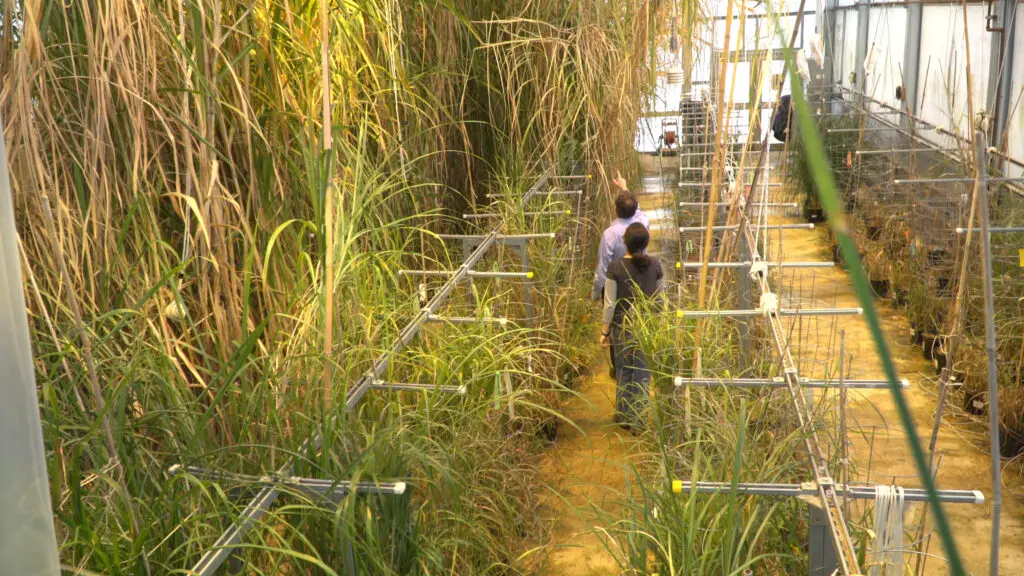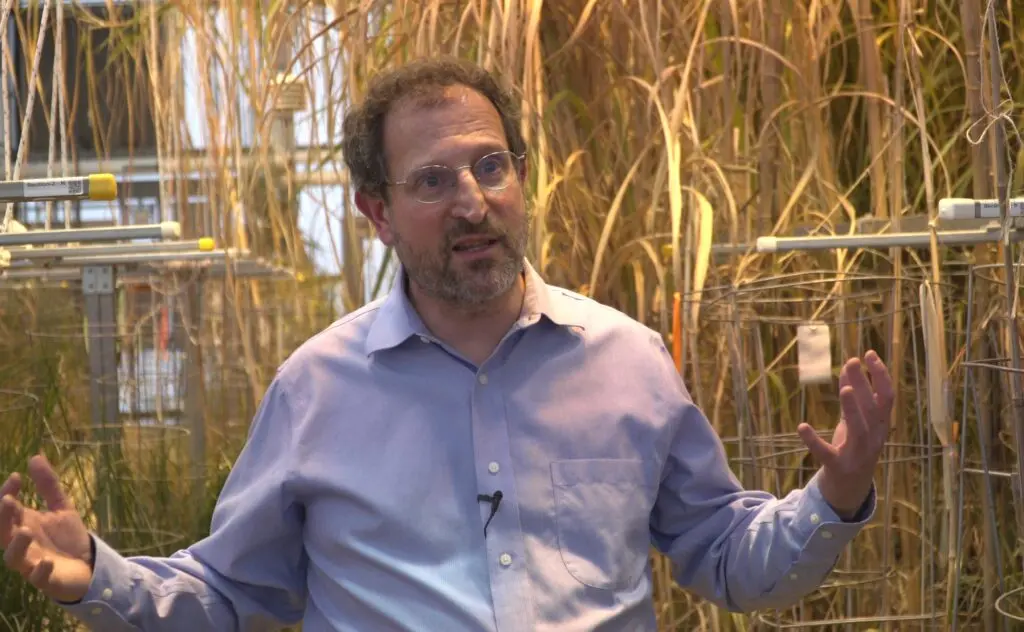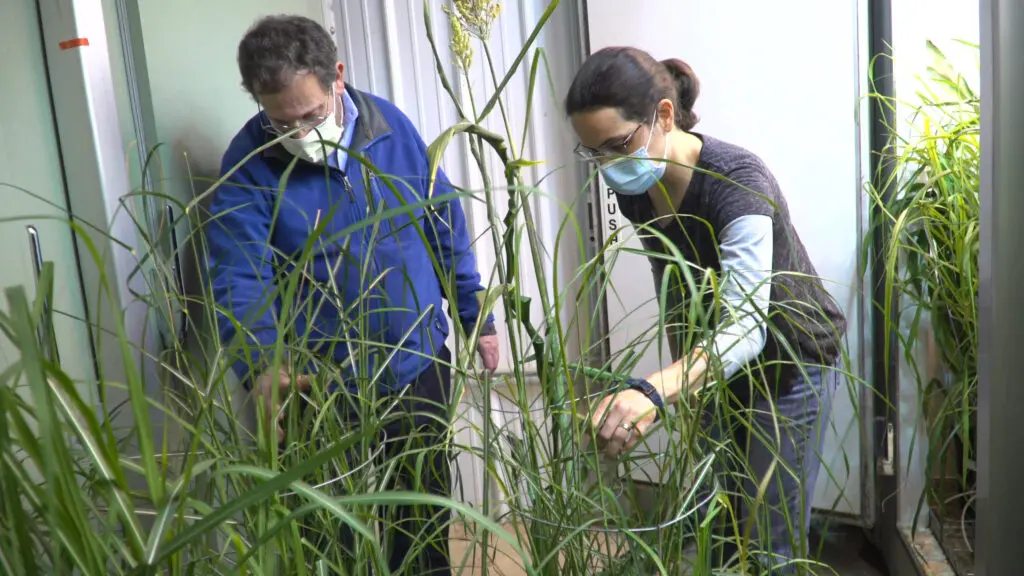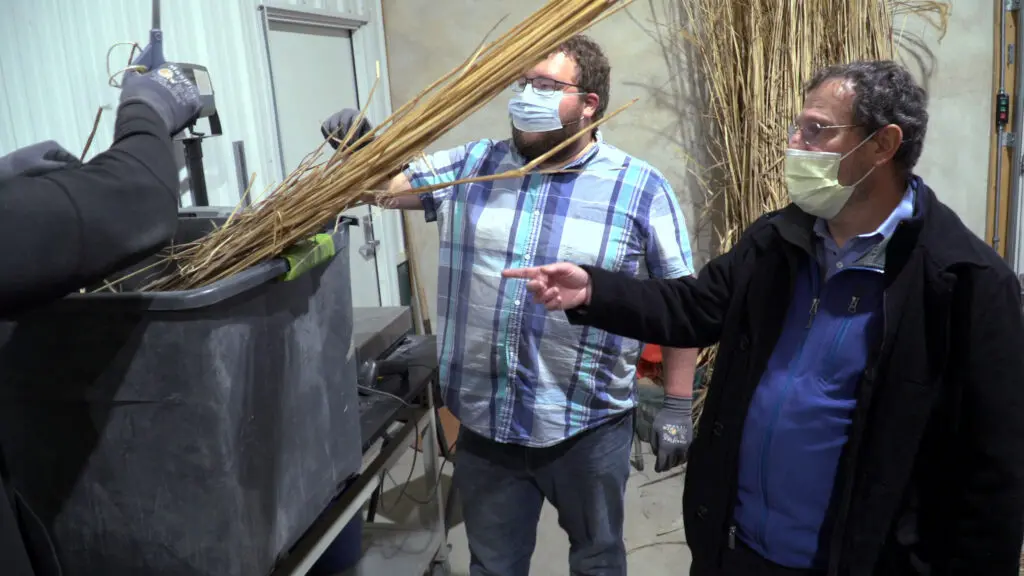The thermometer reads 25 degrees on this snowy winter day, but it’s toasty warm inside the Illinois Energy Farm greenhouse, heated by a biomass boiler fueled with crops grown onsite. It’s the perfect climate for the towering grasses tended by Erik Sacks, CABBI’s new Deputy Theme Leader for Feedstock Production research and an Associate Professor of Crop Sciences at the University of Illinois.
A New York City native, Sacks gravitated to plants as a child and is now an expert on the breeding of miscanthus, a perennial grass and promising bioenergy feedstock. As the snowpack slides down the greenhouse roof with a boom, Sacks explains his research to promote beneficial traits in miscanthus and transfer some of its hardiness to tropical sugarcanes — all in an effort to build a better bioenergy crop. In our Q&A, he also discusses his love of plants (and miscanthus in particular) and the potential of CABBI’s bioenergy work.
What is the overall focus of your research for CABBI?

For CABBI, the focus of my research is on the genetics and breeding of miscanthus, and also of miscanthus as a genetic resource to improve sugarcane. Miscanthus is a relatively new bioenergy crop, and one of the limitations that we have is that there’s really only three cultivars that are available to growers and they’re very similar to each other. And the U.S. has a lot of growing environments. So those cultivars have some limitations in how well adapted they are, say, in the Midwest where it’s very cold in the winter, or in the mid-South where the latitude is much lower. Here in the Midwest, if we have a very cold winter, especially in an establishment year, they may not survive the winter very well. And then in the South they may flower too early to be optimally producing high biomass. So for the Midwest we would like greater cold tolerance and winter hardiness. For the South we’d like them to flower late and have more biomass. So we’re working on those kinds of traits, as well as stress tolerance.
For example, if you drive around the Midwest here in the springtime, you’ll often notice these areas of farmland that are flooded and where the crops have died. We call those prairie potholes. A lot of this area used to be prairie and often wetland prairie. Some miscanthus are more tolerant of that flooding than others. And that might be an area where it could help farmers out by producing a crop that doesn’t compete with other crops — because they’re not getting any yield off those potholes anyway.
How long have you been with CABBI?
Since the beginning. We’re nearing the end of our first five-year phase. And I’ve been with the University of Illinois since 2010, starting with the Energy Biosciences Institute. I was recruited to work on miscanthus — I had worked on miscanthus previously for a private company, so I’ve had a lot of experience with this crop.
What is your primary role as the new Deputy Theme Leader for Feedstock Production?

I’m coordinating the breeding and genetics group. That’s a fun activity to get us all working toward common goals and reporting in a consistent manner, and to help the Theme Leader (Emily Heaton) out wherever possible. I also worked with the team to help formulate CABBI’s renewal proposal with the U.S. Department of Energy, to convey what everybody is working on and our goals for the next five years.
What would you say are some of CABBI’s most important accomplishments to date?
There have been quite a few. But I think one of the unique features about CABBI is to develop high oil-producing grasses, whether they’re energy cane or miscanthus or sorghum. And that’s a really unique concept because the plants don’t normally produce a lot of oil; they may produce sugars or starches and accumulate those. And yet there has been quite good success in increasing the amount of oil that these plants can accumulate. And that’s ground-breaking. It’s not a final product just yet; there’s a lot of work still to be done. But I think there’s a very strong proof of concept that is quite encouraging.
What are your goals as Deputy Theme Leader over the next few years?
Renewal. We have a lot of fun and wonderful things in progress in the Feedstock Production Theme going forward. And certainly there’s going to be more work going forward on the oil and improving that, and getting that into more commercial backgrounds. And then I think increasing biotic and abiotic stress tolerances, and for miscanthus, getting better adaptation to the different U.S. growing environments. Sugarcane and miscanthus are perennial crops. They’re long-living plants. But it also means that the cycle of breeding is very long typically. So we’re developing genomic selection models, and we’re using drones — in collaboration with (CABBI Director) Andrew Leakey — to phenotype more efficiently. The idea is to use these technologies to decrease the length of the breeding cycle, to make the efficiency of our improvements better, and that will be a breakthrough that will have advantages for many years to come for all sorts of people, not just within CABBI.
What prompted your interest in plant science?
Oh boy. I’ve been interested in plants since a very early age. And I had good mentors. I grew up in an apartment building, and an elderly neighbor, who was retired, had hundreds of house plants, and she needed people to water her plants when she was away. So that was my first job in grade school. I got $10 and a fluorescent light setup. And then I used to go to all the plant societies and learn about plants, go to the Philadelphia flower show, that sort of thing. But then I started getting closer to college, and at that time there was a huge famine in Ethiopia, and I started to think, “Wow, my passion in plants could be used towards making crops that are going to solve this problem of hunger.” So that really drove me to get into plant science research. I went to my local land grant college (Cornell University), and I was hooked. My major in undergrad was plant breeding, and I’ve stuck with it ever since. No regrets.
What do you love about miscanthus in particular?

Oh my gosh. If you’re into plant breeding, you have to be excited about genetic diversity. And here’s essentially a wild plant, with a few selections, that has a geographic range from eastern Russia into the tropics of New Guinea, New Caledonia, and it’s just so diverse. There’s so much interesting stuff going on in these plants, and we’ve only just touched the surface. I’ve really enjoyed collecting in Russia, in Japan, visiting sites in China. It’s just been really interesting to see where these plants are from, how they’ve adapted to all these unique environments. And it’s a close relative to sugarcane and it’s in New Guinea, where sugarcanes were domesticated. So these plants have been interacting for a long time.
Tell us about your work in the greenhouse, in terms of crossing sugarcane and miscanthus.
This is our main crossing house, and it has very tall sidewalls so we can flower these sugarcanes. And really what we’re trying to do is use miscanthus as a genetic resource to improve energy cane. Miscanthus has, from some places, exceptional winter hardiness and cold tolerance and low temperature photosynthesis, very exceptional for a warm season grass. We’d like to move those traits into these canes, which are tropical. The other thing that miscanthus has is a lot of disease resistance. And we already have some hybrids with parents that are interspecific parents, intergeneric parents really, between cane and saccharum and miscanthus that have high levels of disease resistance to four major diseases of sugarcane. We’re interested in bringing that back into an energy cane background.
We’re also breeding miscanthus in its own right for adaptation to the Midwest and to the Southern U.S. with our collaborators at Mississippi State University and soon to be Alabama A&M University. So we’ll have hardiness zone 8, hardiness zone 7, and we’re at hardiness zone 5 here — we’ll have a range of environments for testing.
Can you explain the growth chamber experiments you’re working on with miscanthus and sugarcane?
In the growth chamber experiment we have a collection of Miscanthus sacchariflorus, one of the two parental species that makes up Miscanthus x giganteus, which is the type we grow for biomass. So these came from different latitudes, all throughout its native range, from nearly 50 degrees latitude in eastern Russia to around 35 degrees latitude in China, along the Yangtze River. And we’re looking at how long days, like 16.5-hour days, or short days, like 12.5-hour days, affect how long it takes for these different plants to get to reproductive stage, when they’ll go dormant, when they’ll produce a lot of rhizomes. And then we can use that information to help us time the crosses between the miscanthus and the canes, or between different types of miscanthus. The more tropical and subtropical miscanthus tend to have higher biomass potential, but they’re not winter hardy here. The ones from the north tend to be very winter hardy, but they have lower biomass potential. Well, we’d like the best of both worlds. But they won’t flower at the same time unless we can manipulate the flowering time, trick them into flowering at the same time, and then we can put them together. And that’s what we’re learning to do.
What happens after crops are harvested, in terms of processing?

Sometimes when we have smaller plots we will cut individual plants. What you saw earlier was us taking them out of the biomass driers, which were actually heated by burning biomass, and we were then weighing those dried samples to get the dry biomass weight. We can learn which ones are heavier, which ones are lighter, yield more, yield less, so that we can make selections for further crosses and also understand the genetics. Some of those samples were in trials where a graduate student is looking at variations in these biomass traits and relating them to markers, and trying to develop genomic selection models to predict at the seedling stage, so we don’t have to wait three years to figure out which one of those individuals would be among the best for biomass yield.
That biomass is used to heat hot water not just for the dryers, but actually this greenhouse, too. This is a very sustainable greenhouse. All the heat is produced by biomass we grow here at the farm. It’s very warm and tropical in here. This is like Florida weather, which is great for the canes.
How many different types of miscanthus do you have growing here?
We have probably the largest germplasm collection of miscanthus anywhere outside of Asia — and probably the most genetically diverse germplasm collection even including Asia. With funding from DOE (through prior projects actually, not just CABBI) we’ve had collaborators in China, Japan, Korea, and as I said we went collecting in eastern Russia. So we’ve collected from all the sites. Using our molecular genetics studies, we have found that there are seven genetic groups of Miscanthus sinensis, and six genetic groups of Miscanthus sacchariflorus, and we have representatives of all those groups here in Illinois. Some can’t be grown outside because it’s too cold for them, so we grow them in the greenhouse only; some are grown outside as well as inside.
We’ve been taking those sets of plants that belong to a genetic group, which usually belongs to a geographic region — let’s say northern Japan or central Japan — and we intermate those plants, and then we take those populations, half-sib families, and we grow them out in replicated trials in the fields. And then we can look at the genetics of the individuals but also the families and choose the best ones and then advance those families into a subsequent generation. Let’s say we want them to be higher yielding, or later flowering, or more winter hardy. We can move that bell curve, the distribution of that population, over to where we want it, over generations.
Where will all of this take us someday, in terms of bioenergy and sustainability?
I hope that the research that we’re doing here will eventually translate to crops grown in farmers’ fields that contribute to a sustainable bioeconomy. It won’t be the only solution for energy and products in the future, but I think there’s an opportunity to bolster U.S. agriculture and make us more sustainable at the same time. And we’re in the foundations of that right here. We’re going to make a great future, I’m sure.
— Article by CABBI Communications Specialist Julie Wurth